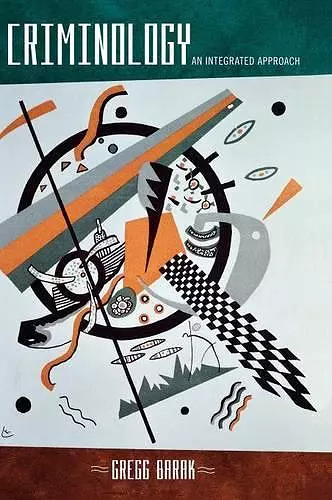Criminology
An Integrated Approach
Format:Hardback
Publisher:Rowman & Littlefield
Published:16th Sep '09
Currently unavailable, and unfortunately no date known when it will be back
This hardback is available in another edition too:
- Paperback£77.00(9780742547131)

Criminology: An Integrated Approach is the first criminology textbook to provide an integrated perspective on the developing global and historical relations that unite the studies of criminology/criminologists, criminal justice/justicians, and crime/crime control in the 21st century. In order to achieve this integration, the book is divided into three parts. Part I, "a unifying analysis of crime and crime control" does three things: First, the studies of criminology and criminal justice are reunited in the context of globalization. Second, the official and unofficial forms of crime and criminal behavior are examined domestically and globally. Third, unlike most criminology texts, theories are also used to explain the administration of criminal justice, the behavior of law enforcement and crime control, as well as the policies of sentencing and punishment. Part II, "explaining criminal behavior and crime" outlines the changing historical conditions of criminological inquiry and provides detailed overviews of the various contributions made from economics and law, biology, psychology, and sociology. These criminological theories are also subject to a critique based on the partialities of most of these explanations and on the need for developing integrated explanations. Part III, "integrating criminological strands," is divided between presenting elaborations of contemporary criminological integrations that transcend disciplinary boundaries and elaborating on both domestic and international policies of crime reduction and justice enhancement in an age of globalization.
The book is beautifully organized, well-written, and very interesting. It has a trio of virtues: the author does an excellent job of defining and showing the advantages of integrative approaches. He also refuses to allow readers to separate crime from criminal justice. This strikes me as distinctive and rather original. And I very much like the way he helps us to see how U.S. criminology exists in relation to a global approach. -- Lynn Chancer, Hunter College, CUNY
Barak provides the first integrated analysis of crime, criminal justice, and criminology through a global lens, revealing the importance of a global perspective for the study of crime and justice in the 21st century. While moving seamlessly from micro bio-psychological, interactive-social process to the macro cultural-structural forces that shape crime and our responses to it, the author presents the reader with a feast of the latest criminological ideas in this sumptuous tome. -- Stuart Henry
Barak takes on the study of criminology in a novel way, integrating more mainstream theories with perspectives that have received less attention. I also am very impressed with the way in which he incorporates the new thinking about globalization and crime and adding a critique of the risk perspectives. . . . Overall, this book will be an important text for courses where instructors want to explore different ideas and approaches about crime. It is provocative in a positive way. -- Leslie W. Kennedy, Rutgers School of Criminal Justice
In this text, Barak does a phenomenal job bringing attention to areas of study that are often overlooked or are just now beginning to emerge within the field....It greatly enhances ones understanding of globalization as related to criminological study, and integration. Some of the material presented within this text is of a complex nature. For this reason, I feel this text is appropriate for upper level undergraduate courses or even graduate classes. For general reading, I highly recommend this text for those who are interested in integration or globalization as it relates to criminology. * Journal of Theoretical and Philosophical Criminology *
ISBN: 9780742547124
Dimensions: 263mm x 188mm x 30mm
Weight: 1016g
398 pages